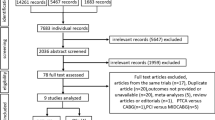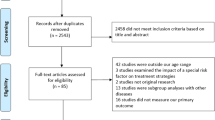Abstract
Clinically, coronary artery bypass grafting (CABG) or percutaneous coronary intervention (PCI) is generally used to treat patients with ischemic heart failure. However, the optimal treatment strategy remains unknown. This study examined the efficacy of the two coronary revascularization strategies for severe ischemic heart failure by using a meta-analysis. Studies comparing the efficacy of CABG and PCI were obtained from PubMed, EMBASE, Google Scholar and Cochrane Central Register of Controlled Trials (CENTRAL). The quality of each eligible article was evaluated by Newcastle-Ottawa Quality Assessment Scale (NOS), and the meta-analysis was performed using Stata version 12.0 software. Eventually, 12 studies involving 9248 patients (n=4872 in CABG group; n=4376 in PCI group) were subject to the meta-analysis for subsequent pooling calculation. The pooled hazard ratio (HR) [HR=0.83, 95% CI (0.76, 0.90), P<0.001; heterogeneity, P=0.218, I2=22.9%] of CABG compared with that of PCI revealed a statistical superiority of CABG to PCI in terms of the long-term mortality. Furthermore, CABG showed more advantages over PCI with respect to the incidence of myocardial infarction [HR=0.51, 95% CI (0.39, 0.67), P<0.001; heterogeneity, P=0.707, I2=0%] and repeat revascularization [HR=0.40, 95% CI (0.27, 0.59), P<0.001; heterogeneity, P<0.001, I2=80.1%]. It was concluded that CABG appears to be more advantageous than PCI for the treatment of ischemic heart failure in the given clinical setting.
Similar content being viewed by others
References
Global, regional, and national age-sex specific allcause and cause-specific mortality for 240 causes of death, 1990–2013: a systematic analysis for the Global Burden of Disease Study 2013. Lancet, 2015,385(9963):117–171
Lee MS, Yang T, Dhoot J, et al. Meta-analysis of studies comparing coronary artery bypass grafting with drug-eluting stenting in patients with diabetes mellitus and multivessel coronary artery disease. Am J Cardiol, 2010,105(11):1540–1544
Ghali JK. Ischemic heart failure. J La State Med Soc, 1995,147(5):202–207
Bolli R, Marban E. Molecular and cellular mechanisms of myocardial stunning. Physiol Rev, 1999,79(2):609–634
Ramanathan K, Abel J, Park J, et al. Surgical versus percutaneous coronary revascularization in patients with diabetes and acute coronary syndromes. J Am Coll Cardiol, 2017,70(24):2995–3006
Kulik A. Quality of life after coronary artery bypass graft surgery versus percutaneous coronary intervention: what do the trials tell us? Curr Opin Cardiol, 2017,32(6):707–714
Fortier J, Shaw R, Glineur D, et al. Percutaneous coronary intervention versus coronary artery bypass grafting: where are we after NOBLE and EXCEL? Curr Opin Cardiol, 2017,32(6):699–706
Wells GA, Shea BJ, O'Connell D, et al. The Newcastle–Ottawa Scale (NOS) for assessing the quality of non-randomized studies in meta-analysis. Vol. 7. 2014.
Moher D, Liberati A, Tetzlaff J, et al. Preferred reporting items for systematic reviews and meta-analyses: the PRISMA statement. BMJ, 2009,339:b2535
Ahn JM, Oh JH, Sun BJ, et al. AS-230 comparisons of drug-eluting stents vs. coronary-artery bypass grafting for patients with multi-vessel disease and severely compromised ventricular dysfunction. Am J Cardiol, 2011,107(8 Supplement):87A
Bangalore S, Guo Y, Samadashvili Z, et al. Revascularization in patients with multivessel coronary artery disease and severe left ventricular systolic dysfunction: Everolimus-eluting stents versus coronary artery bypass graft surgery. Circulation, 2016,133(22):2132–2140
Buszman P, Szkrobka I, Gruszka A, et al. Comparison of effectiveness of coronary artery bypass grafting versus percutaneous coronary intervention in patients with ischemic cardiomyopathy. Am J Cardiol, 2007, 99(1):36–41
Cleland JG, Calvert M, Freemantle N, et al. The Heart Failure Revascularisation Trial (HEART). Eur J Heart Fail, 2011,13(2):227–233
Gioia G, Matthai W, Gillin K, et al. Revascularization in severe left ventricular dysfunction: outcome comparison of drug-eluting stent implantation versus coronary artery by-pass grafting. Catheter Cardiovasc Interv, 2007,70(1):26–33
Hannan EL, Wu C, Walford G, et al. Drugeluting stents vs. coronary-artery bypass grafting in multivessel coronary disease. N Engl J Med, 2008,358(4):331–341
LaBarbera M, Hui P, Shaw R. Coronary artery disease in patients with reduced left ventricular systolic function treated with medicine, surgery, or percutaneous coronary intervention: a retrospective review of outcomes within a multicenter healthcare system. J Am Coll Cardiol, 2012,60(17):B107
Marui A, Kimura T, Nishiwaki N, et al. Comparison of five-year outcomes of coronary artery bypass grafting versus percutaneous coronary intervention in patients with left ventricular ejection fractions</=50% versus >50% (from the CREDO-Kyoto PCI/CABG Registry Cohort-2). Am J Cardiol, 2014,114(7):988–996
Nagendran J, Norris CM, Graham MM, et al. Coronary revascularization for patients with severe left ventricular dysfunction. Ann Thorac Surg, 2013,96(6):2038–2044
Fortuna D, Nicolini F, Guastaroba P, et al. Coronary artery bypass grafting vs percutaneous coronary intervention in a 'real-world' setting: a comparative effectiveness study based on propensity scorematched cohorts. Eur J Cardio-Thorac Sur, 2013,44(1):E16–E24
Toda K, Mackenzie K, Mehra MR, et al. Revascularization in severe ventricular dysfunction (15% < OR = LVEF < OR = 30%): a comparison of bypass grafting and percutaneous intervention. Ann Thorac Surg, 2002,74(6):2082–2087
Yang JH, Choi SH, Song YB, et al. Long-term outcomes of drug-eluting stent implantation versus coronary artery bypass grafting for patients with coronary artery disease and chronic left ventricular systolic dysfunction. Am J Cardiol, 2013,112(5):623–629
Barnes E, Dutka DP, Khan M, et al. Effect of repeated episodes of reversible myocardial ischemia on myocardial blood flow and function in humans. Am J Physiol Heart Circ Physiol, 2002,282(5):H1603–H1608
Camici PG, Prasad SK, Rimoldi OE. Stunning, hibernation, and assessment of myocardial viability. Circulation, 2008,117(1):103–114
Lang RM, Bierig M, Devereux RB, et al. Recommendations for chamber quantification: a report from the American Society of Echocardiography's Guidelines and Standards Committee and the Chamber Quantification Writing Group, developed in conjunction with the European Association of Echocardiography, a branch of the European Society of Cardiology. J Am Soc Echocardiogr, 2005,18(12):1440–1463
Morrison DA, Sethi G, Sacks J, et al. Percutaneous coronary intervention versus coronary artery bypass graft surgery for patients with medically refractory myocardial ischemia and risk factors for adverse outcomes with bypass: a multicenter, randomized trial. Investigators of the Department of Veterans Affairs Cooperative Study #385, the Angina With Extremely Serious Operative Mortality Evaluation (AWESOME). J Am Coll Cardiol, 2001,38(1):143–149
Alderman EL, Andrews K, Bost J, et al. Comparison of coronary bypass surgery with angioplasty in patients with multivessel disease. N Engl J Med, 1996,335(4):217–225
Bundhun PK, Pursun M, Teeluck AR, et al. Adverse cardiovascular outcomes associated with coronary artery bypass surgery and percutaneous coronary intervention with everolimus eluting stents: A metaanalysis. Sci Rep, 2016,6:35869
Fihn SD, Blankenship JC, Alexander KP, et al. 2014 ACC/AHA/AATS/PCNA/SCAI/STS focused update of the guideline for the diagnosis and management of patients with stable ischemic heart disease: a report of the American College of Cardiology/American Heart Association Task Force on Practice Guidelines, and the American Association for Thoracic Surgery, Preventive Cardiovascular Nurses Association, Society for Cardiovascular Angiography and Interventions, and Society of Thoracic Surgeons. Circulation, 2014,130(19):1749–1767
Windecker S, Kolh P, Alfonso F, et al. 2014 ESC/ EACTS Guidelines on myocardial revascularization: The Task Force on Myocardial Revascularization of the European Society of Cardiology (ESC) and the European Association for Cardio-Thoracic Surgery (EACTS). Developed with the special contribution of the European Association of Percutaneous Cardiovascular Interventions (EAPCI). Eur Heart J, 2014,35(37):2541–2619
Schwann TA, Engoren M, Bonnell M, et al. Comparison of late coronary artery bypass graft survival effects of radial artery versus saphenous vein grafting in male and female patients. Ann Thorac Surg, 2012,94(5):1485–1491
Moses JW, Leon MB, Popma JJ, et al. Sirolimuseluting stents versus standard stents in patients with stenosis in a native coronary artery. N Engl J Med, 2003,349(14):1315–1323
Maslow AD, Regan MM, Panzica P, et al. Precardiopulmonary bypass right ventricular function is associated with poor outcome after coronary artery bypass grafting in patients with severe left ventricular systolic dysfunction. Anesth Analg, 2002,95(6):1507–1518
Cao C, Manganas C, Horton M, et al. Angiographic outcomes of radial artery versus saphenous vein in coronary artery bypass graft surgery: a meta-analysis of randomized controlled trials. J Thorac Cardiovasc Surg, 2013,146(2):255–261
Author information
Authors and Affiliations
Corresponding author
Additional information
This meta-analysis was supported by National Natural Science Foundation of China (No. 81570427 and No. 81270322).
Rights and permissions
About this article
Cite this article
Xiao, J., Xu, F., Yang, Cl. et al. Preferred Revascularization Strategies in Patients with Ischemic Heart Failure: A Meta-Analysis. CURR MED SCI 38, 776–784 (2018). https://doi.org/10.1007/s11596-018-1944-8
Received:
Revised:
Published:
Issue Date:
DOI: https://doi.org/10.1007/s11596-018-1944-8




